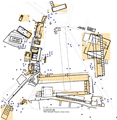Liturgies and Benefactions
The rich citizens of Athens were expected to benefit the public as a whole by
spending their own money to increase the amenities of life for all. In the case of the
civic duties called
liturgies1 (“work for
the people; public service”), the wealthy were legally obligated to provide
financial benefits to the city-state. Especially costly liturgies included duties such
as
paying the costs2 of putting on
drama in the annual public festivals3 of Athens or financing and serving as an officer on a
warship4 in the city-state's fleet. In other cases the wealthy provided benefactions
that were not obligatory but nevertheless also displayed their civic mindedness and
generosity toward their fellow citizens. Such benefactions included providing animals
for public sacrifices and the feasting on their roasted meat that followed and
constructing public buildings and other architectural improvements in the
city5. Although the
costs of liturgies and benefactions, which could be heavy, obviously were a drain on
the resources of a family as a whole, they were normally peformed in the name of the
male head of the household. Spending generously to provide benefits for the common
good was regarded as a primary component of male aristocratic virtue. Generous
benefactors of the public earned increased social eminence as their reward and perhaps
greater favor with their fellow male citizens when they ran for elective office, such
as that of general. Liturgies and benefactions performed by the rich in the interest
of the city compensated to a certain extent for the lack of any regular income or
property taxes.
Benefactions by Cimon and his family
Cimon,6 an aristocratic and wealthy man, gained great fame for his costly
benefactions to his fellow citizens. He was renowned, for example, for
opening
his orchards to let others pick whatever they wanted,7 but his most famous benefactions were architectural. He
paid to have
landscaping with shade trees and running tracks installed in open areas of Athens,
and he also footed the enormous bill for the construction of footings for
defensive walls8 to link the urban center of Athens and the
harbor at Piraeus9 some seven kilometers away. Cimon's brother-in-law also participated in the
family tradition of benefiting Athens by paying for highly-visible public building
projects. He had built as a gift to the city the renowned
Painted Stoa.
10 Stoas were narrow, colonnaded
buildings open along one side, whose purpose was to provide shelter from sun or rain
for these conversations. The Painted Stoa stood on the edge of the
central
open area, 11 the agora, at the center of the city. The
agora served both as a market area where
merchants could set up small stalls and as a gathering place for Athenian men to
discuss politics and every other issue affecting their lives in the city-state. It
was the commercial and social heart of Athens. The crowds of men who came to the
agora daily for conversation would cluster inside
the
Painted Stoa12, whose walls were decorated with paintings of great moments in Greek history
commissioned from the most famous painters of the time, Polygnotus and Mikon. That
one of the stoa's paintings portrayed the battle of Marathon in which Cimon's
father, Miltiades, had won glory was only appropriate, since the building had been
paid for by the husband of Cimon's sister, probably with financial assistance from
Cimon himself.









